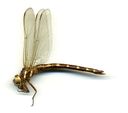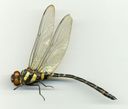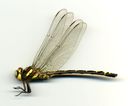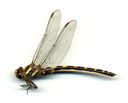Spiketails
Cordulegastridae
Classification
- Phylum: Arthropoda
- Subphylum: Hexapoda
- Class: Insecta
- Order: Odonata
- Suborder: Anisoptera
- Family: Cordulegastridae
Pronunciation
How to pronounce Cordulegastridae: //ˌkɔːrdʊlɛˈɡæstrɪdiː//
These audio files are automatically generated. While they are not always 100% accurate, they are a good starting point.
Images






Summary
Cordulegastridae, commonly known as spiketails, are a family of large dragonflies known for their distinctive yellow markings and the female's spike-like ovipositor. They prefer clean, cold water habitats and can be found along woodland streams, exhibiting both aquatic (nymph) and terrestrial (adult) life stages.
Physical Characteristics
Very large slender dark dragonflies with striking yellow markings on the abdomen and yellow stripes on the sides of the thorax; males have yellow foreheads and slightly clubbed abdomens, while females have brown foreheads and a prominent ovipositor which extends from the tip of the abdomen; they typically range from 2.5 to 3 inches long.
Identification Tips
Females are easily identified by their large spike (modified genital plate) extending beyond the tip of the abdomen used as an ovipositor. Males can be recognized by their yellow foreheads and territorial flying behavior.
Habitat
Prefer small to mid-sized cold clear streams, often forested; nymphs are aquatic and conceal themselves in sand or silt, while adults fly above clear streams and small rivers in wooded areas.
Distribution
Primarily Holarctic, with a notable presence in the southeastern United States; also found in North America, South America, Europe, Asia, and Africa.
Diet
Nymphs are ambush predators, consuming any prey they can catch; they are known to eat smaller larvae of the same species. Adults hunt high in forest vegetation, usually capturing prey resting on leaves or branches (gleaning).
Life Cycle
Adults are typically active from spring into early summer, with a peak in June; lifespan ranges from 3 to 5 years.
Reproduction
Females hover just above the water's surface in a vertical position and make repeated dips into the water to lay eggs in the substrate, often in sand or silt.
Conservation Status
Multiple species are of concern; some have been deemed highly or moderately vulnerable, with specific species endangered due to significant habitat loss.
Ecosystem Role
As predators, they help control the populations of insects and other small aquatic creatures, contributing to the balance of their ecosystem.
Collecting Methods
- Netting males while they patrol over water
- Observing females when they are egg-laying
Tags
- dragonflies
- spiketails
- Cordulegastridae
- Holarctic
- aquatic
- terrestrial